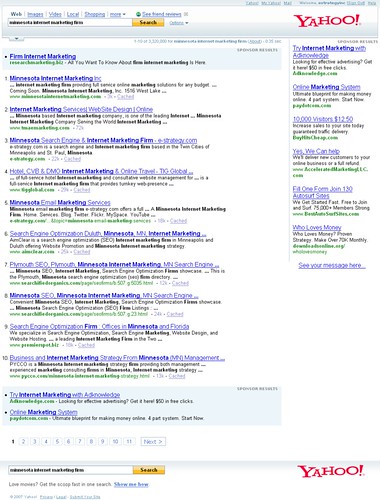The description text that accompanies the links within search engine results are often overlooked for their persuasion and branding potential.
The purpose of that text, first and foremost, must be to persuade the searcher to click on your link. That requires creative, search optimized copy that is informed by the search phrase that you are targeting.
But people don’t always click. When people search, they are exposed to 10 to 20 messages that are associated with the links on the results page. Even if people don’t click on your link, they can still be exposed to your message through the link text and the description text below the link. This is search engine branding.
The pages of your site should be optimized to produce a "micro message" through these search results that, even if the searcher doesn’t click, helps to brand your organization.
The following is an example of a branding problem I had with e-strategy.com.
Taking Control Of Your Meta Description Text
As is often the case, your own work usually gets pushed down your list of priorities "until you have time."
Such was the case with the search engine listings for e-strategy.com. The rankings for the site were fine, but the search engine branding of the site’s rankings were not being displayed as I wanted them.
The problem was in the Yahoo! rankings for the site, specifically for the snippet text beneath the link of my listings. Search engines will usually gather text on a given web page to be used in the text snippet below the link for their search engine results pages. But if your site is listed in the Yahoo! Directory or the Open Source Directory Project, search engines may use text from the description of the site in the directory.
That is precisely what was happening with e-strategy. com. Unfortunately, the text I provided for the description of the site when I first submitted it to the Yahoo! Directory has long since become outdated. This is what the listing looked like with snippet text drawn from the Yahoo! Directory (Click on the graphic to see a larger version):
I didn’t want the text to say "catering to the small business and nonprofit markets" anymore, so I needed to change this. If I cared enough, I’d pay the $300 and resubmit the site to Yahoo with an updated description but I just don’t think the costs justifies the little traffic I’d likely get from directory listings. Fortunately, there’s a less expensive way to address this.
The three major search engines, Google, Yahoo! and MSN all support the NOODP robots meta tag that tells search engines not to use description text from the Open Directory Project. The code is to be placed within the <HEAD></HEAD> tag set of your page: <meta name="robots" content="noodp" />.
Unfortunately, only Yahoo! supports the NOYDIR robots meta tag that tells search engines not to use the description text from the Yahoo! Directory: <meta name="robots" content="noydir" />. Fortunately, my only problem is with Yahoo! anyway, so that suits me just fine. Here’s what my listings look like after implementing these tags (Click on the graphic to see a larger version):
You’ll see from the third listing, that the snippet text now reads "e-strategy.com is a search engine and Internet marketing firm based in the Twin Cities of Minneapolis and St. Paul, Minnesota."
That’s more like it.
And because search engines first look to the Meta Description tag for snippet text, you have far more control over how that text looks by prohibiting directory descriptions.
The e-Strategy Academy covers all aspects of digital marketing including search optimization & marketing, email marketing, social media marketing, video marketing, mobile marketing & public relations.

